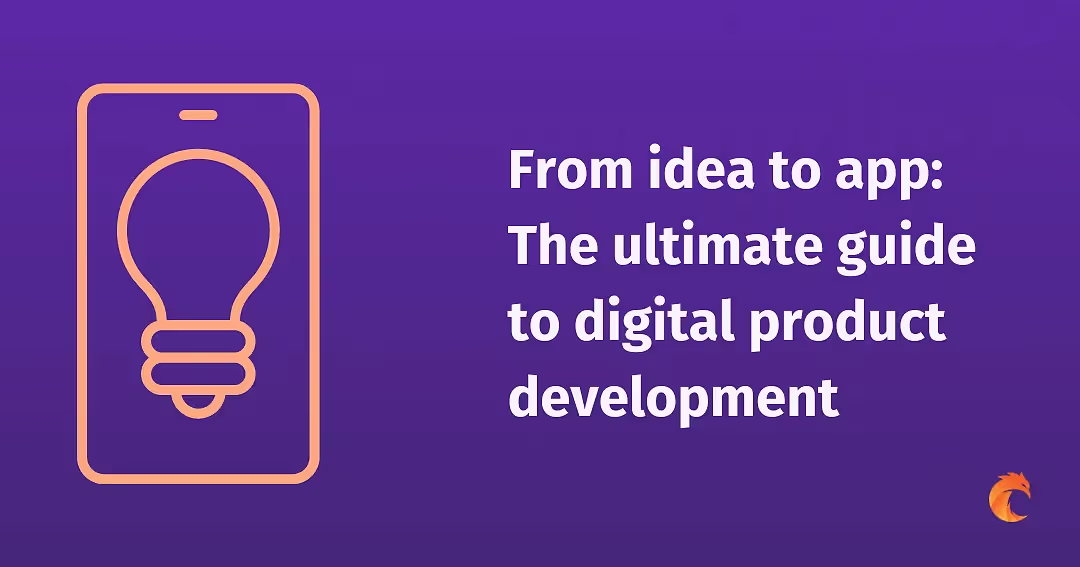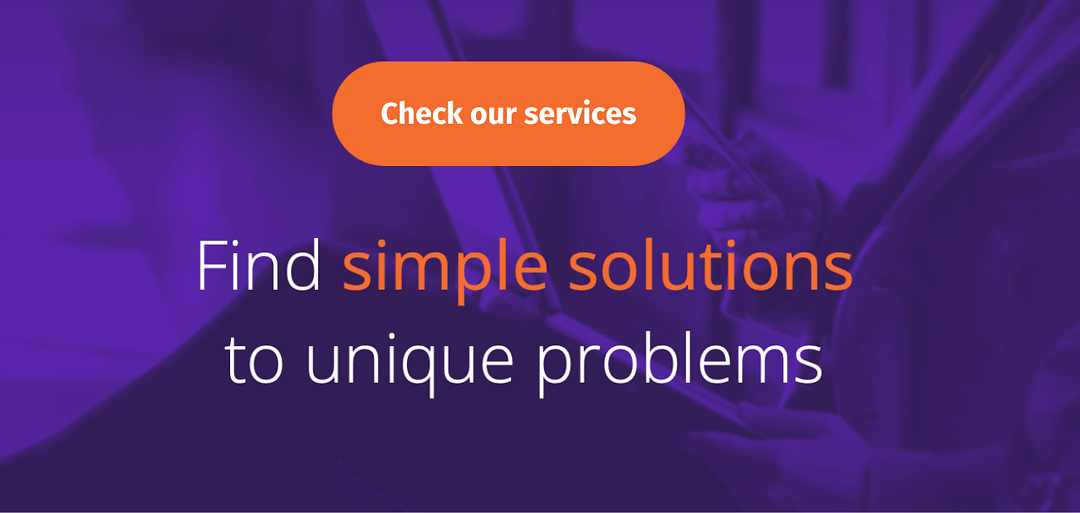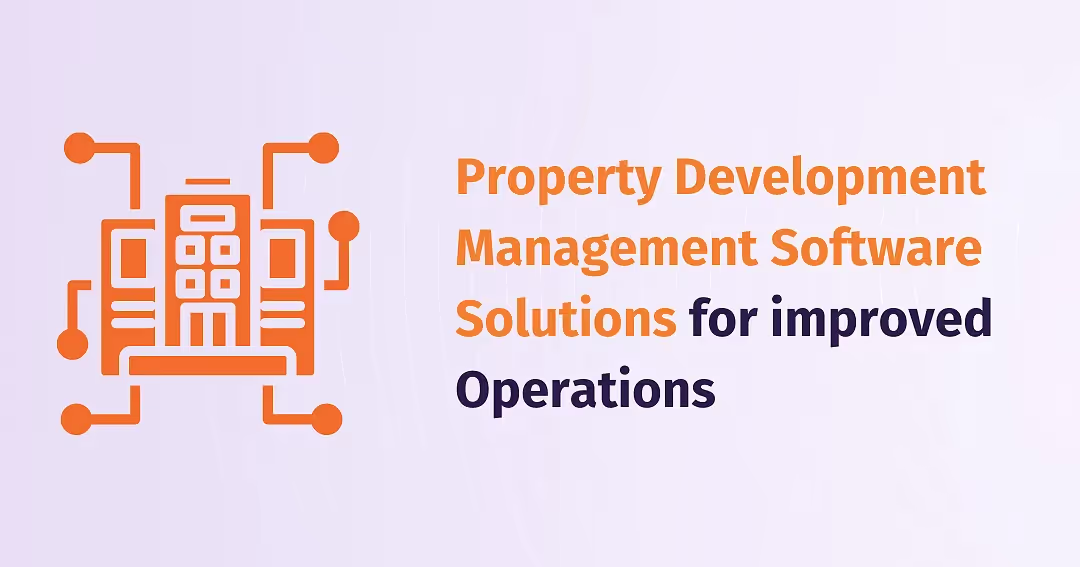From idea to app: The ultimate guide to digital product development


In the digital age, the development of digital products has become a crucial aspect of business growth and innovation.
Introduction
From mobile apps to web platforms, digital products serve as key touchpoints between businesses and their customers, facilitating interactions, transactions, and the delivery of value. However, the journey from an idea to a fully functional digital product is fraught with challenges. This guide aims to navigate you through this complex process, providing insights into each stage of digital product development.
The Importance of Digital Product Development
Digital product development transcends the creation of an app or a website. It's about crafting a solution that adds value to the users and propels business growth. In the current digital-centric world, businesses across various sectors are leveraging digital products to engage with their customers, streamline operations, and create new revenue channels.
A well-developed digital product can enhance customer experience, boost brand visibility, and provide valuable insights into customer behavior. It can also open up new opportunities for innovation and growth. For instance, a mobile app can provide a platform for offering personalized services, pushing timely notifications, and gathering real-time feedback. Similarly, a web platform can serve as a one-stop solution for customers to explore, purchase, and review products or services. Developing a digital product is not a straightforward task. It requires a deep understanding of the market, user needs, and the latest technological trends.
Challenges in Digital Product Development
The path from an idea to a fully functional digital product is filled with challenges. These can range from defining the product concept, designing an intuitive user interface, developing the product using the right technologies, to testing the product for quality assurance, and finally deploying it successfully.
One of the key challenges in digital product development is understanding the user needs accurately. Without a clear understanding of what the users want, businesses risk developing a product that fails to meet the market demand.
Another challenge is choosing the right technology stack for development. The choice of technologies can significantly impact the product's performance, scalability, and maintenance cost.
Other challenges include ensuring timely completion of the development process, managing the development cost, and navigating the ever-evolving technological landscape.
In the following sections, we'll delve deeper into each stage of digital product development and provide insights on how to navigate these challenges.

Ideation
Understanding the Market and the User Needs
The market
Before you embark on your digital product development journey, it's crucial to understand the market landscape. This involves researching your competitors, identifying market trends, and understanding the needs and preferences of your target audience.
Market research can provide valuable insights into what your competitors are doing, what's working for them, and where gaps exist that your product could fill. It can also help you understand the current trends in your industry, which can inform your product design and development strategy.
Additionally, it's essential to analyze the potential market size and growth prospects for your product. This involves studying industry reports, market forecasts, and demographic data. Understanding the market size can help you estimate the potential revenue for your product and inform your go-to-market strategy.
Armed with this information, you can start to conceptualize your product, defining its features, functionality, and overall user experience.
The User Needs
Identifying user needs is a critical step in the digital product development process. It involves understanding who your users are, what problems they're facing, and how your product can solve those problems.
User needs can be identified through various methods. Surveys and interviews can provide direct insights from potential users. User testing of existing products can reveal pain points and areas for improvement. Data analytics can provide insights into user behavior and preferences.
Once you've identified your users' needs, you can start to design your product to meet those needs. This might involve developing specific features, creating a user-friendly interface, or ensuring your product is accessible to all users. But before that, don't forget about your product conceptualization.
Conceptualizing the Product
Conceptualizing the product is where your idea starts to take shape. This involves defining the product's features, functionality, and overall user experience. It's also the stage where you consider how your product will stand out from the competition.
When conceptualizing your product, it's important to keep the user at the center of your design process. This means designing features and functionality that meet user needs and enhance the user experience. It also means considering how users will interact with your product, from the first point of contact to the point of conversion and beyond.
At this stage, it's important to consider the technical feasibility of your product. This involves considering the technologies and resources required to develop your product and assessing whether they align with your budget and timeline.
Don't forget about creating a product roadmap. This is a strategic document that outlines the key stages of the product development process, from ideation and design to development and launch. A well-defined product roadmap can guide your team through the development process and help manage expectations with stakeholders.

Design
User Experience (UX) Design: Ensuring User Satisfaction
While UI design focuses on the look and feel of your product, user experience (UX) design is concerned with the overall experience of using your product. This includes aspects like usability, performance, and the emotional response elicited by your product. A good UX design ensures that users can achieve their goals easily and efficiently when using your product.
UX design involves understanding the user's journey through your product, from the initial interaction to the final goal completion. It involves creating a product that is not only functional and easy to use, but also enjoyable and satisfying.
UX design is a multidisciplinary field that involves aspects of psychology, design, and technology. It requires a deep understanding of user behavior and a user-centric approach to design. It's about creating a product that meets the user's needs and exceeds their expectations.
Good UX design can have a significant impact on the success of your digital product. It can enhance user satisfaction, increase user retention, and drive business growth.
User Interface (UI) Design: The Art of Creating Appealing Apps
The user interface (UI) is the part of your digital product that users interact with. A well-designed UI is intuitive, easy to use, and visually appealing. It should guide users through the product's functionality in a seamless and enjoyable way.
UI design involves creating the visual elements of your product, such as buttons, icons, and menus. It also involves designing the layout of these elements to ensure a logical and efficient user flow. Good UI design can enhance the user experience, increase user engagement, and ultimately drive conversions.
The Role of UX/UI Design in Digital Products
UX/UI design plays a crucial role in digital product development. It not only determines how your product looks and feels but also how it functions and how users perceive it. A well-designed digital product can enhance user satisfaction, increase user engagement, and ultimately drive business success.
UX/UI design is not a one-time process but an ongoing one. It involves continuously testing and refining your product based on user feedback and changing market trends. This iterative approach ensures that your product remains relevant and continues to meet user needs.
Incorporating UX/UI design into your digital product development process can help you create a product that stands out in the market and delivers real value to users.
Development
Agile Development: A Modern Approach to Software Development
Agile development emphasizes flexibility, collaboration, and customer satisfaction. It involves working in short, iterative cycles, allowing for frequent feedback and adjustments. This approach can enhance the quality of your digital product and reduce the risk of project failure.
Agile development is characterized by its iterative and incremental approach. Instead of planning and executing the entire project at once, Agile breaks the project down into smaller, manageable chunks called "sprints". Each sprint involves planning, designing, coding, and testing, and results in a working piece of software.
One of the key benefits of Agile development is its flexibility. It allows teams to adapt to changes quickly and efficiently, whether these changes are in project requirements, market trends, or technology.
Another benefit is its focus on customer satisfaction. By involving the customer in the development process and delivering working software early and frequently, Agile can help ensure that the final product meets the customer's needs and expectations.
Incorporating AI into Digital Product Development
Artificial Intelligence (AI) can greatly enhance the capabilities of your digital product. It can enable features like personalized recommendations, voice recognition, and automated customer service. Incorporating AI into your digital product development process can help you create a more advanced and competitive product.
AI can be used in various stages of the digital product development process. In the ideation stage, it can help analyze market trends and user behavior to generate product ideas. In the design stage, Artificial Intelligence can help create personalized user interfaces and experiences. In the development stage, AI can automate certain tasks, speeding up the development process. In the testing stage, it can help identify bugs and performance issues.
AI in the digital product can also enhance the user experience. For example, AI can enable personalized user experiences based on user behavior and preferences. It can also automate customer service through chatbots, providing users with instant responses to their queries.
However, incorporating AI into your digital product development process requires careful planning and execution. It requires a clear understanding of what AI can and cannot do, and how it can add value to your product.
Testing and Deployment
The Importance of Quality Assurance
Quality assurance (QA) is a crucial part of the digital product development process. It involves testing your product to ensure it functions correctly and meets the defined quality standards. QA can help you identify and fix bugs, improve the product's performance, and enhance the user experience.
QA involves various types of testing. Each type of testing serves a specific purpose and helps ensure that your product is ready for launch.
By investing in QA, you can ensure that your product is of high quality and meets user expectations. This can enhance user satisfaction, increase user retention, and drive business growth.
Different Types of Testing in Software Development
There are different types of testing in software development. These include functional testing, usability testing, performance testing, and security testing. Each type of testing helps ensure that your digital product functions correctly, is easy to use, performs well, and is secure.
Functional testing involves testing the functionality of your product to ensure it works as expected. This includes testing individual functions, user interactions, and data processing.
Usability testing involves testing the user interface and user experience of your product. This includes testing the layout, design, and navigation of your product, as well as how users interact with it.
Performance testing involves testing the speed, responsiveness, and stability of your product under different loads. This includes testing how your product performs under normal and peak conditions, and how it recovers from failures.
Security testing involves testing the security features of your product to ensure it is safe from threats. This includes testing for vulnerabilities, conducting penetration testing, and ensuring compliance with security standards.
Continuous Integration: Ensuring Consistent Quality
Continuous integration is a practice in software development where developers frequently merge their changes to a central repository. Automated builds and tests are then run to catch bugs early and ensure consistent quality. This practice can help you maintain a high level of quality throughout the development process.
There might be numerous benefits of continuous integration. It can help detect and fix bugs early, reduce integration problems, and provide immediate feedback to developers. This can enhance the quality of your product and speed up the development process. By incorporating continuous integration into your digital product development process, you can ensure that your product is always in a releasable state. This can enhance your ability to deliver updates and new features to your users quickly and efficiently.
Preparing for Deployment
Before deploying your digital product, it's important to prepare thoroughly. This involves finalizing the product's features, conducting final testing, and ensuring that the product is ready for use. It's also important to prepare your team for the launch and to have a plan in place for handling any issues that may arise.
Preparation process involves considering the deployment environment. This includes the server infrastructure, the network conditions, and the security measures in place. It's important to ensure that your product is compatible with the deployment environment and that it can handle the expected load.
Finally, the plan should outline the deployment process, including the steps to be taken, the roles and responsibilities of each team member, and the timeline for the deployment.
Launching the App: What to Expect
Launching a digital product is a significant milestone, but it's also just the beginning. After the launch, you'll need to monitor the product's performance, gather user feedback, and make necessary adjustments. You'll also need to market your product to reach your target audience and achieve your business goals.
During the launch, you can expect a surge in user activity. This can put a strain on your server infrastructure and can lead to performance issues if not managed properly. It's important to monitor your product's performance closely during this time and to have a plan in place for scaling up your resources if needed.
After the launch, you can expect to receive feedback from your users. This feedback can provide valuable insights into how your product is being used and where improvements can be made. It's important to listen to this feedback and to make adjustments to your product based on it.
Post-Launch Support and Maintenance
After the launch, your digital product will require ongoing support and maintenance. This includes fixing bugs, adding new features, and updating the product to keep up with technological advancements and user expectations. Providing good post-launch support can enhance user satisfaction and loyalty.
Bug fixing involves identifying and resolving issues that affect the functionality or performance of your product. This requires a robust testing and debugging process, as well as a system for tracking and managing bugs.
Adding new features involves updating your product to meet changing user needs and market trends. This requires a deep understanding of your users and the market, as well as a flexible development process.
Updating your product involves keeping your product up-to-date with the latest technologies and standards. This can involve updating the programming languages, frameworks, and libraries used in your product, as well as updating your product's design and functionality to meet current user expectations.
Outsourcing Digital Product Development
The Benefits of Outsourcing
Outsourcing digital product development can save your time and resources, give you access to specialized expertise, and allow you to focus on your core business activities. For more insights into this topic, check out our articles on the Pros of Development Outsourcing and How to Create Good Cooperation with the Software Development Company.
Outsourcing can provide you with a team of experienced developers who can deliver high-quality work in a timely manner. It can also reduce your operational costs, as you won't need to invest in hiring and training an in-house team. Furthermore, outsourcing can provide you with flexibility, allowing you to scale your development efforts up or down as needed.
However, outsourcing also comes with its own challenges. These include managing a remote team, ensuring quality control, and protecting intellectual property. It's important to choose a reliable outsourcing partner and to establish clear communication and management processes.
How to Create Good Cooperation with the Software Development Company
Creating good cooperation with a software development company involves clear communication, setting clear expectations, and establishing a strong working relationship. It's important to treat your outsourcing partner as an extension of your own team, involving them in your planning and decision-making processes.
Clear communication is crucial for success. This involves regularly updating your outsourcing partner on your project goals, progress, and changes. It also involves listening to their feedback and suggestions. Regular meetings, clear documentation, and open communication channels can facilitate effective communication.
Setting clear expectations involves defining the project scope, timeline, and deliverables clearly and ensuring that both parties understand and agree on these. It also involves setting clear standards for quality and performance.
Establishing a strong working relationship let to build trust and respect with your outsourcing partner. This involves treating them as a valued partner, recognizing their expertise, and appreciating their contributions. It also help to resolve conflicts in a constructive manner and working together to overcome challenges.
Read our article about the good cooperation with the Software Development Company to know how to do it properly.
The Role of Elixir in Digital Product Development
Introduction to Elixir Programming
Elixir is a dynamic, functional language designed for building scalable and maintainable applications. It's known for its performance, scalability, and fault-tolerance, making it a great choice for digital product development.
Elixir leverages the Erlang VM, known for running low-latency, distributed, and fault-tolerant systems. This makes Elixir particularly suitable for web applications that require high concurrency and performance.
Elixir also supports metaprogramming, allowing developers to write code that writes code, which can lead to more maintainable and less repetitive code. It also has a friendly syntax and a strong support community, making it a popular choice among developers.
Adoption of Elixir by Top Companies
Elixir has been adopted by numerous top companies for their digital product development. Companies like Pinterest, Discord, and Bleacher Report have used Elixir to build high-performance, scalable applications.
Pinterest, for example, used Elixir to manage their notification system, handling tens of millions of events per day. Discord, a popular communication platform, used Elixir to handle their massive, real-time communication infrastructure.
The success of these companies demonstrates the potential of Elixir in digital product development. For more information, check out our articles on the Adoption of Elixir by top companies and 5 top-tier companies that use Elixir.
Conclusion
The Journey from Idea to App: A Recap
The journey from idea to app is a complex process involving several stages, from ideation and design to development, testing, and deployment. Each stage requires careful planning and execution, and the use of modern methodologies and technologies can greatly enhance the outcome.
Despite the challenges, developing a digital product can be a rewarding experience. It allows you to bring your ideas to life, create value for users, and drive business growth. With the right approach and the right partner, you can navigate this journey successfully.
How Curiosum Can Help You in Your Digital Product Development Journey
At Curiosum, we specialize in digital product development. We offer a range of services. Our team of experts can guide you through each stage of the product development process, helping you turn your idea into a successful digital product.
Whether you're looking to outsource your digital product development or seeking advice on your next project, we're here to help. Check out our articles on Pros of development outsourcing, and How to create good cooperation with the software development company for more insights.
In the world of digital product development, the journey from idea to app is a challenging yet rewarding one. With the right approach and the right partner, you can turn your idea into a successful digital product that meets the needs of your users and drives your business forward.
Ready to scale your business with the right tech partner?
Related posts
Dive deeper into this topic with these related posts
You might also like
Discover more content from this category
This article looks at how such system can automate tasks, improve efficiency, and integrate with your systems, aiding your decision-making process.
This article walks you through how personalizing your GIS project can improve operations, whether in real estate, urban planning, or beyond.
What is green coding? In this article, we will discuss the principles of green software development and how Elixir can help you write more sustainable code.





